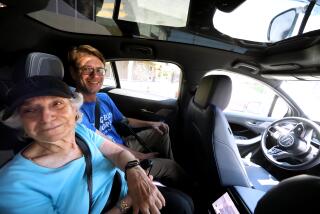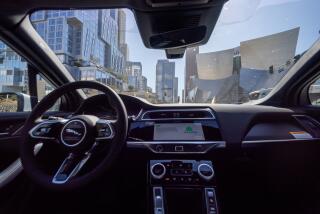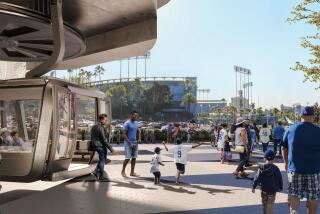Who wants a ‘podcar’? Not me
In her Sept. 8 Op-Ed article, Catherine G. Burke, an associate professor at USC’s School of Policy, Planning and Development, touts the “podcar” system as an able replacement for cars and roads. She says that such a system would provide “on-demand, private, nonstop travel.” The electric-powered podcars would ride on infrastructure similar to a monorail or people mover.
Burke writes: “Picture the car as an elevated, driverless taxi. It’s under computer control, so there would be no accidents, thereby saving lives and lowering insurance costs. Podcars operate on demand, waiting at off-line stations; they can be summoned if one is not available when you arrive at the station. Each vehicle can hold four people, yet the system can be cost-effective even with a single rider for each trip.”
Not bad. But I’d have to share these things with other people who used them before me. Sometimes, I would have to wait for them to pick me up. I couldn’t choose which podcar I’d want and which features I’d like. Once I leave the podcar network, I’m left out in the cold when it comes to public transportation. To me, this sounds like riding a subway.
No, I don’t like this idea, and I’ve got something better: the car.
The car is brilliant! Yours is your own. If there’s a mess in it, you put it there, not some of the multitudes of strangers with whom you must share a podcar. Like a loyal steed, your car is always there for you where you left it. There’s virtually no waiting for a ride unless a valet parked your car. You can choose the exact feature set, style, entertainment system, quality and comfort levels that suit you. And your car can go anywhere, including all the way home to your garage.
But there are major problems with cars, and the podcar system would solve many of them: accidents, congestion and the fact that many of our freeways are already beyond their maximum volume capacity with no more room for growth.
Enter the Automated Highway System. It’s cheaper and quicker than the podcar system to set up and would utilize our existing highway surfaces without the need to build more roads. What’s more, we already have virtually all of the technology we’d need.
Picture this: You go into your garage, get into your (electric or hydrogen-powered?) car, turn it on and choose your destination. You drive yourself through city streets until you reach the Automated Highway System. You then take your hands off the wheel and the cruise control takes effect. You feel a surge of speed as the car accelerates safely to as fast as 150 miles per hour as it joins the other traffic, following only a few yards behind the car in front. Using sensors on the vehicle and magnetized markers on the road surface, the onboard computer is communicating with the other vehicles on the road as they coordinate themselves into tight platoons of eight to 25 cars, minimizing air resistance, improving fuel efficiency and ensuring that a vast volume of traffic is able to fit onto the road space. Your commute time is fast, reliable and effortless. As you approach your exit, your car leaves the platoon into the enter-exit lane and then out of the Automated Highway System completely, at which point you can resume driving.
Sounds far-fetched? It’s certainly less so than the podcar system, which requires us all to use a new kind of carriage on an entirely new network of monorails. And it’s already been tested with great success. In fact, several major automakers are developing autonomous cruise control systems.
Who wants a podcar? We’re done waiting for public transportation. The future is in making our existing automobiles capable of high-speed, congestion-free, emissions-free, hands-free travel. Now that’s a solution.
John Wright hosts a daily afternoon radio show on KLPZ 1380 AM along the California-Arizona state line and blogs frequently on libertarianism and current affairs at John-Wright.net. This piece is adapted from his blog.
More to Read
A cure for the common opinion
Get thought-provoking perspectives with our weekly newsletter.
You may occasionally receive promotional content from the Los Angeles Times.










